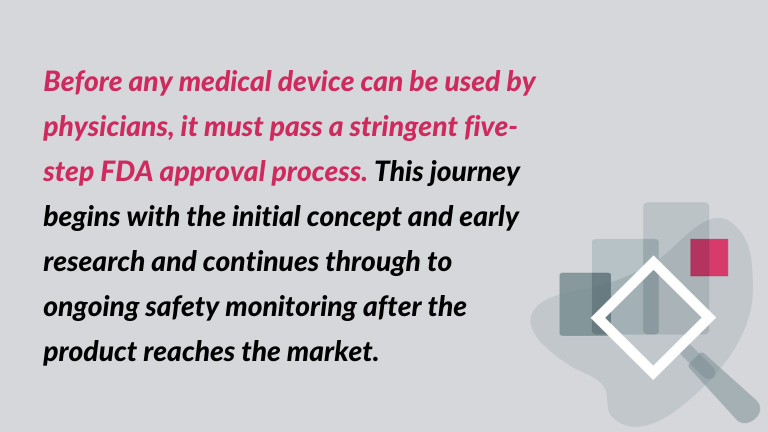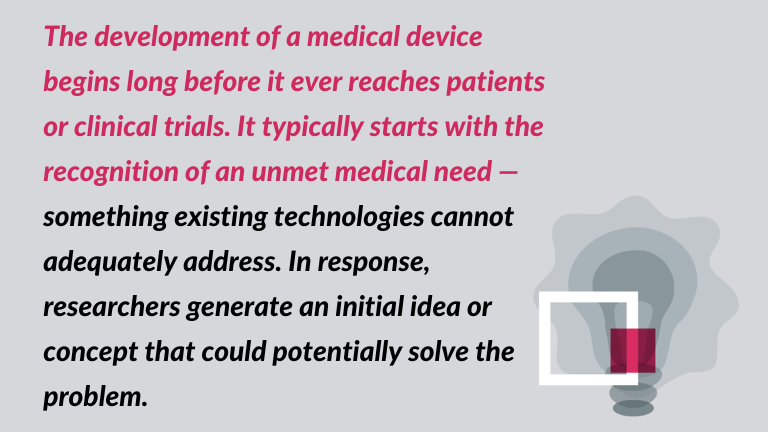FDA device approval process works: navigating the medical device journey
The FDA approval process for medical devices is a crucial step in ensuring the safety and effectiveness of innovative technologies that are introduced into hospitals, clinics, and doctors’ offices worldwide. For manufacturers of medical devices, understanding this pathway is not only a regulatory requirement but also a vital factor for market success. We will explore how the FDA approval process operates, from the initial concept to testing, risk analysis, and post-market monitoring of the device. This guide outlines the requirements, challenges, and essential steps that every medical device must undergo before it can enter the market.
The 5 key stages of the FDA device approval process
Physicians can use a medical device only after it passes a stringent five-step FDA approval process. This journey begins with the initial concept and early research and continues through to ongoing safety monitoring after the product reaches the market. Here is a list of these crucial steps, which together outline the roadmap for medical device development and regulatory evaluation in the United States.
Step 1: Device discovery and concept
Step 2: Preclinical research prototype
Step 3: Pathway and Approval
Step 4: FDA review
Step 5: FDA Post-market safety monitoring

Device discovery and concept
In this post, we will look at step 1, which is Device discovery and concept. It is essential to understand the classification of medical devices, as the development and approval process differs based on the device’s classification and associated risk level.
What are the FDA’s classification guidelines for medical devices? The FDA classifies medical devices based on the degree of risk involved in using them. This categorization can change as new scientific discoveries or advancements in research emerge.
Regulators initially classify a medical device by assigning it to one of three classes.
The initial classification of medical devices
Class I: General controls
Class I medical devices are considered to present the lowest risk to patients and users. This category includes products such as oxygen masks or basic surgical instruments. Although these devices are low-risk, they are still regulated to ensure safety and effectiveness.
Devices classified as Class I are subject to “general controls,” which represent the foundational level of oversight by the FDA. These controls include requirements such as compliance with good practices and proper registration with the FDA. They also involve maintaining detailed records, adhering to established standards, and reporting any adverse events. Together, these measures help maintain trust and ensure consistent quality in the production and use of low-risk medical devices.
Class II: General controls with special controls
Experts consider Class II medical devices to carry a moderate level of risk, which is higher than that of Class I devices. As a result, they require more stringent regulatory oversight. In addition to general controls such as good manufacturing practices and mandatory FDA registration, Class II devices are subject to special controls aimed at enhancing their safety and effectiveness. These special controls may include specific labeling requirements, tailored performance standards for each device type, and particular testing requirements. This two-tiered regulatory approach helps manage the heightened risks associated with medical devices.
Class III: General controls and premarket approval
Class III medical devices are designed to support or sustain life. Often implanted in the body, these devices can pose significant risks to patient health. Due to their crucial role, any failure of these devices can have serious consequences. Examples of Class III devices include pacemakers and breast implants. Because of their importance, these devices are subject to the strictest regulatory standards. In addition to general controls, manufacturers must obtain premarket approval. This process requires them to provide scientific evidence demonstrating that the device is both safe and effective for its intended use. Regulators ensure, through this thorough review process, that patients and healthcare providers receive only well-tested and proven devices.

From idea to innovation: the early stages of medical device development
The development of a medical device begins long before it ever reaches patients or clinical trials. It typically starts with the recognition of an unmet medical need—something existing technologies cannot adequately address. In response, researchers generate an initial idea or concept that could potentially solve the problem. To assess its feasibility, they create a proof of concept, which maps out the preliminary steps required to test whether the idea is viable in practice. Not all concepts advance; many are found to be impractical or ineffective. However, those that demonstrate real potential to continue through further refinement and development, setting the stage for more rigorous testing and evaluation.
Conclusion: Confidently navigating the FDA process
The FDA designed the device approval process to promote technical developments in healthcare while prioritizing patient safety. Each stage, from recognizing a medical need to the early conceptual phases and device categorization, is vital. These steps ensure that only high-quality, safe, and effective devices reach the market. Manufacturers may more effectively and strategically navigate this complicated landscape with a thorough understanding of the classification system and regulatory expectations from the outset. This knowledge allows for better decision-making throughout the development process. As we’ve covered in this piece, long-term success depends on the foundation that is laid early on. Appropriate classification and concept validation are especially critical to that foundation.
Resources: